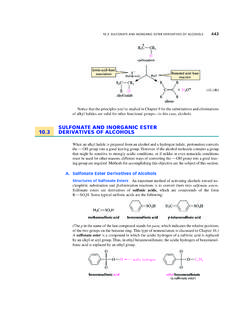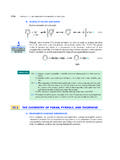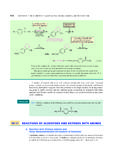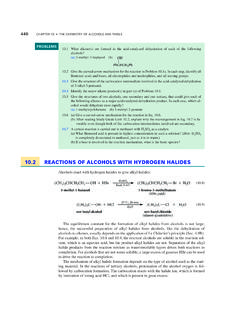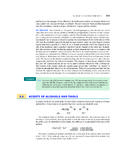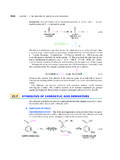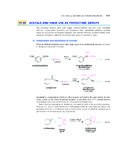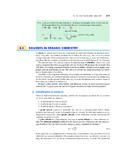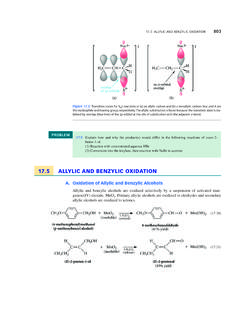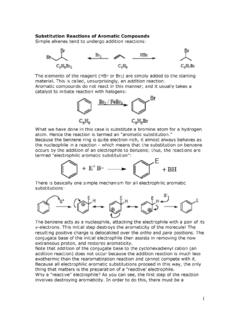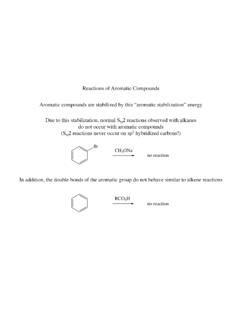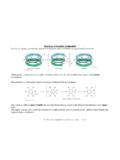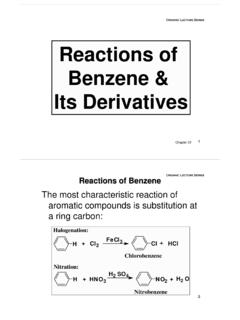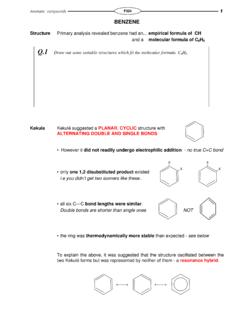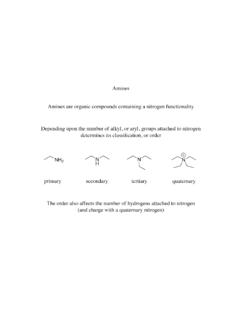Transcription of ELECTROPHILIC AROMATIC SUBSTITUTION …
1 750 CHAPTER 16 THE CHEMISTRY OF BENZENE AND ITS DERIVATIVESThis hybridization allows one of its electron pairs to occupy a 2porbital, which has the samesize, shape, and orientation as the carbon 2porbitals of the ring. In other words, an oxygen 2porbital overlaps more effectively with the carbon 2porbitals of the ring than an oxygen sp3or-bital would. (We learned about the same effect in resonance-stabilized allylic systems; p. 713).The UV spectrum of anisole is a direct consequence of this (a) Explain why compound Ahas a UV spectrum with considerably greater lmaxvalues andintensities than are observed for ethylbenzene.(b) In view of your answer to part (a), explain why the UV spectra of compounds Band Carevirtually How could you distinguish styrene (PhLCHACH2) from ethylbenzene by UV spec-troscopy? AROMATIC SUBSTITUTION reactions OF BENZENEThe most characteristic reaction of benzene and many of its derivatives is ELECTROPHILIC aro-matic SUBSTITUTION .
2 In an ELECTROPHILIC AROMATIC substitutionreaction, a hydrogen of an aro-matic ring is substituted by an electrophile that is, by a Lewis acid. The general pattern of anelectrophilic AROMATIC SUBSTITUTION reaction is as follows, where E is the electrophile:(Note that in this reaction and in others that follow, only one of the six benzene hydrogens isshown explicitly to emphasize that one hydrogen is lost in the reaction.)All ELECTROPHILIC AROMATIC SUBSTITUTION reactions occur by similar mechanisms. This sectionsurveys some of the most common ELECTROPHILIC AROMATIC SUBSTITUTION reactions and theirmechanisms.( )LLLHEY+LEHY+H3C H3C H3C H3C CH3 CH3 CH3 CH3 CH3 ivv$$$$LLM%"B bimesityllmax = 266 nm (e = 700)Cmesitylenelmax = 266 nm (e = 200)LLLC2H5C2H5256 nm (e = 20,000)283 nm (e = 5,100)lmax A= 11/26/08 9:06 AM Page ELECTROPHILIC AROMATIC SUBSTITUTION reactions OF BENZENE751A. Halogenation of BenzeneWhen benzene reacts with bromine under harsh conditions liquid bromine, no solvent, andthe Lewis acid FeBr3as a catalyst a reaction occurs in which onebromine is substituted fora ring hydrogen.
3 (Because iron reacts with Br2to give FeBr3, iron filings can be used in place of FeBr3.) Ananalogous chlorination reaction using Cl2and FeCl3gives reaction of benzene with halogens differs from the reaction of alkenes with halogensin two important ways. First is the type of product obtained. Alkenes react spontaneously withbromine and chlorine, even in dilute solution, to give addition of benzene, however, is a SUBSTITUTION reaction;a ring hydrogen is replacedbya halogen. Second, the reaction conditions for benzene halogenation are muchmore severethan the conditions for addition of halogens to an first step in the mechanism of benzene bromination is the formation of a complexbetween Br2and the Lewis acid of this complex results in a formal positive charge on one of the bromines. A posi-tively charged bromine is a better electron acceptor, and thus a better leaving group, than abromine in Br2itself. Another (and equivalent) explanation of the leaving-group effect is that_FeBr4is a weaker base than Br_.
4 (Remember from Sec. that weaker bases are betterleaving groups.) _FeBr4is essentially the product of a Lewis acid base association reaction ofBr_with FeBr3. Therefore, in _FeBr4, an electron pair on Br_has already been donated to Fe,and is thus less available to act as a base, than a naked electron pair on Br_itself.( )a better electron acceptorand better leaving groupa weaker basea stronger basea weaker electron acceptorand poorer leaving group(a nucleophile)Nuc3311 BrLL11 BrFeBr3|_33311 BrL11 BrNuc3311 BrLL11 BrFeBr3 Nuc|3311Br_L311 BrNuc_+|+( )311 BrL311 BrFeBr3311 BrLL11 BrFeBr3|_( )BrBrBr2 y+`( )LHbenzeneBr2+FeBr3 or Fe ( equiv.)bromobenzene(50% yield)LBrHBr+ 11/26/08 9:06 AM Page 751752 CHAPTER 16 THE CHEMISTRY OF BENZENE AND ITS DERIVATIVESAs you learned in Sec. , LBr is a good leaving group. The fact that a much better leaving group than LBr is required for ELECTROPHILIC AROMATIC SUBSTITUTION illustrates how unreactivethe benzene ring the second step of the mechanism, this complex reacts with the pelectrons of the ben-zene ring.
5 The pelectrons act as a nucleophile, the Br as an electrophile, and _FeBr4as a leav-ing this step results in the formation of a resonance-stabilized carbocation, it also disruptsthe AROMATIC stabilization of the benzene ring. Harsh conditions (high reagent concentrations,high temperature, and a strong Lewis acid catalyst) are required for this reaction to proceed ata useful rate because this step does not occur under the much milder conditions used to bringabout bromine addition to an reaction is completed when a bromide ion (complexed to FeBr3) acts as a base to removethe ring proton, regenerate the catalyst FeBr3, and give the products bromobenzene and that loss of ab-proton is one of the characteristic reactions of carbocations (Sec. ).Another typical reaction of carbocations reaction of bromide ion at the electron-deficient car-bon itself doesn t occur because the resulting addition product would not be AROMATIC :By losing a b-proton instead (Eq.)
6 , the carbocation can form bromobenzene, a stable aro-matic A small amount of a by-product, p-dibromobenzene, is also formed in the bromination of benzene shown in Eq. Write a curved-arrow mechanism for formation of ( )FeBr3 BrL123_FeBr3 HHBr|/M%+)does not occurBr123 HHBr/M%"M(not AROMATIC )( )HHvLBr123Br123Br123 FeBr3 BrL123_FeBr3|/%++M( )HHLLFeBr3 BrL12Br123Br123_FeBr4_||||/nM%HBr123M%HB r123M%x!!+ 11/26/08 9:06 AM Page ELECTROPHILIC AROMATIC SUBSTITUTION reactions OF BENZENE753B. ELECTROPHILIC AROMATIC SubstitutionHalogenation of benzene is one of many ELECTROPHILIC AROMATIC substitutionreactions. Thebromination of benzene, for example, is an AROMATIC substitutionbecause a hydrogen of ben-zene (the AROMATIC compound that undergoes SUBSTITUTION ) is replaced by another group(bromine). The reaction is electrophilicbecause the substituting group reacts as an elec-trophile, or Lewis acid, with the benzene pelectrons.
7 In bromination, the Lewis acid is abromine in the complex of bromine and the FeBr3catalyst (Eq. ).We ve considered two other types of SUBSTITUTION reactions : nucleophilic SUBSTITUTION (theSN2 and SN1 reactions , Secs. and ) and free-radical SUBSTITUTION (halogenation of alka-nes, Sec. ). In a nucleophilic SUBSTITUTION reaction, the substituting group acts as a nucle-ophile, or Lewis base; and in free-radical SUBSTITUTION , free-radical intermediates are involved. ELECTROPHILIC AROMATIC SUBSTITUTION is the most typical reaction of benzene and its you learn about other ELECTROPHILIC SUBSTITUTION reactions , it will help you to under-stand them if you can identify in each reaction the following three mechanistic steps:Step 1 Generation of an electrophile. The electrophile in bromination is the complex of brominewith FeBr3, formed as shown in Eq. Step 2 Nucleophilic reaction of the pelectrons of the AROMATIC ring with the electrophile to forma resonance-stabilized carbocation intermediate.
8 The electrophile approaches the p-electron cloud of the ring above or below the plane of themolecule. In the carbocation intermediate, the carbon at which the electrophile reacts becomessp3-hybridized and tetrahedral. This step in the bromination mechanism is Eq. 3 Loss of a proton from the carbocation intermediate to form the substituted AROMATIC com-pound. The proton is lost from the carbon at which SUBSTITUTION occurs. This carbon again be-comes part of the AROMATIC p-electron step in the bromination mechanism is Eq. sequence is classified as electrophilicsubstitution because we focus on the nature ofthe group an electrophile that reacts with the AROMATIC ring. However, the mechanism re-ally involves nothing fundamentally new: like both ELECTROPHILIC addition(Sec. ) and nucle-ophilic SUBSTITUTION (Sec. ), the reaction involves the reactions of nucleophiles, elec-trophiles, and leaving groups.( )X+ ( )HXXEHE resonance-stabilizedcarbocation intermediatea tetrahedral, sp3-hybridized carbon;no longer involved in the p-electron systemelectrophileleaving group+.
9 11/26/08 9:06 AM Page 753754 CHAPTER 16 THE CHEMISTRY OF BENZENE AND ITS DERIVATIVESS tudy Problem a curved-arrow mechanism for the following ELECTROPHILIC SUBSTITUTION the mechanism in terms of the three preceding 1In this reaction, a hydrogen of the benzene ring has been replaced by an isotope D, which mustcome from the D2SO4. Because protons (in the form of Br nsted acids) are good electrophiles, theD2SO4itself can serve as the 2 Reaction of the benzene pelectrons with the electrophile involves protonation of the benzene ringby the isotopically substituted acid:(If you re asking where that extra hydrogen in the carbocation came from, don t forget that eachcarbon of the benzene ring has a single hydrogen that is not shown explicitly in the skeletal struc-ture. One of these is shown in the carbocation because it is involved in the next step.) You shoulddraw the resonance structures of the carbocation 3 Removal of the proton gives the final product:C.
10 Nitration of BenzeneBenzene reacts with concentrated nitric acid, usually in the presence of a sulfuric acid catalyst,to form nitrobenzene. In this reaction, called nitration,the nitro group, LNO2, is introducedinto the benzene ring by ELECTROPHILIC reaction fits the mechanistic pattern of the ELECTROPHILIC AROMATIC SUBSTITUTION reactionoutlined in the previous section:Step 1 Generation of the electrophile. In nitration, the electrophile is |NO2, the nitronium ion. Thision is formed by the acid-catalyzed removal of the elements of water from HNO3.( )H2SO4 LHbenzenenitrobenzene(81% yield)nitricacidHONO2 LNO2H2O++3_OSO3D12 OSO3D12Di|HHD%)aM+L3_OSO3DL12 OSO3D12|HDDi%)aresonance-stabilizedcarbo cation 11/26/08 9:06 AM Page ELECTROPHILIC AROMATIC SUBSTITUTION reactions OF BENZENE755 Step 2 Reaction of the benzene pelectrons with the electrophile to form a carbocation inter-mediate.(Notice that either of the oxygens can accept the electron pair.
